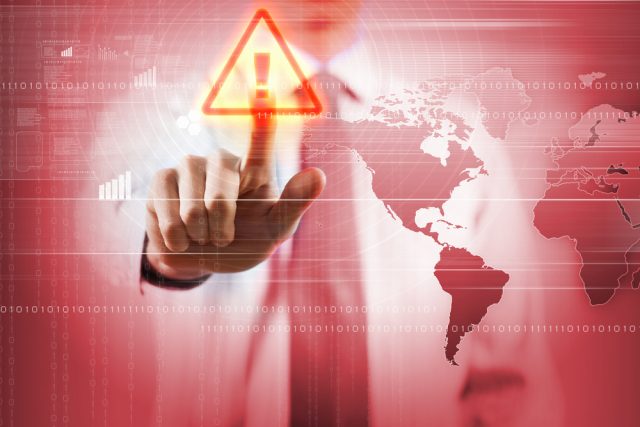5 alarming trends making cybersecurity threats riskier and more expensive

Imagine a future in which every person, object, and service is connected to the internet. Your car knows your destination before you do, your fridge restocks itself, and your doctor can remotely monitor your health. Now imagine that one day, all of those interconnected devices get hacked at once. Your car suddenly careens off the road, your fridge emits a deafening alarm, and your doctor’s office is flooded with false patient data.
This nightmare scenario is becoming increasingly likely, as the world becomes ever more connected and reliant on technology. And it’s not just consumers who are at risk -- businesses are, too. A single cyberattack can cost a company millions of dollars, and the price is only going up as hackers become more sophisticated.
We cannot stress enough how important it is to stay up-to-date on the latest cybersecurity trends and have a robust security system to protect your business. Imagine if a hacker gained access to your company’s confidential data or if you became the victim of a ransomware attack. The damage these kinds of incidents can cause is staggering, and it’s not something any business can afford to ignore.
This article will explore current cybersecurity threats in depth to understand how the landscape of threats has changed.
Five alarming trends in cybersecurity
One rule of thumb in business is that it’s always cheaper to prevent a problem than to fix it. The same goes for cybersecurity. By being proactive and staying up-to-date on the latest threats, you can save your business a lot of time, money, and hassle down the road.
Here are five of the most alarming trends in cybersecurity:
1. The rise of AI-powered attacks
In an AI-powered attack, hackers use artificial intelligence to automate the process of identifying and exploiting weaknesses in a system. This allows them to scale their attacks and target more victims in a shorter period. What’s more, AI-powered attacks are often designed to evade traditional security measures, making them particularly dangerous for businesses not using the latest security technologies.
Let’s take a closer look at how AI is being used in cybersecurity attacks:
- Machine learning -- ML is a type of AI that allows computers to learn from data and improve their performance over time. Hackers can use machine learning algorithms to scan for systems’ vulnerabilities and exploit them.
- Natural language processing -- NLP is a type of AI that enables computers to understand human language. Cybercriminals can use NLP to automatically generate phishing emails that are difficult for people to spot.
- Predictive analytics -- Predictive analytics is a type of AI that uses historical data to predict future events. Hackers can use predictive analytics to identify potential targets for attacks.
2. The growth of ransomware
Ransomware is malware that puts a victim’s access to their files at ransom, only decrypting them once the price is paid. This type of attack has been on the rise in recent years, as it is an easy way for hackers to make money.
This is extremely frightening for businesses, as a ransomware attack can bring their operations to a screeching halt. And even if they do pay the ransom, there is no guarantee that the hackers will actually decrypt their files. That’s because businesses have more data that is valuable to hackers, and they are often willing to pay a higher ransom to get their data back. In fact, the average ransom paid by businesses has increased from $812,000 in 2020 to $1M+ in 2021.
3. The proliferation of IoT devices
IoT devices are gadgets connected to the internet that can communicate with each other. Examples of IoT devices include smart TVs, smart thermostats, and smart doorbells.
As if it wasn’t enough to worry about the cybersecurity of our computers and smartphones, now we have to worry about the security of our IoT devices as well. The problem is that these devices are often not built with security in mind, which makes them easy targets for hackers, who can use them to gain access to a victim’s home or business network.
The proliferation of IoT devices has also created new opportunities for hackers to exploit. For example, IoT devices are often connected to other devices on a network, meaning that a hacker who gains access to one device can potentially gain access to all the devices on the network. Talk about a nightmare scenario!
4. The rise of cloud computing
Cloud computing is a type of internet-based computing that delivers various computer services -- such as servers, storage, databases, networking, software, analytics, and intelligence -- over the internet. This way of working offers businesses faster innovation rates, flexible resources, and economies of scale.
Although cloud computing has many benefits, it also comes with some risks. For example, if a hacker gains access to a cloud computing platform, they can potentially access the data of all the businesses using that platform. This is a serious concern as more and more businesses are moving to the cloud -- the global market for cloud computing is expected to grow from 480.04 billion in 2022 to 1,712.44 billion by 2029.
5. Unsecure payment gateways
As the world moves increasingly online, businesses are relying on payment gateways to process transactions and accommodate customers who want to pay with credit cards or through 3rd party platforms like PayPal.
However, many payment gateways are not adequately secured, which makes them vulnerable to attack. This is a serious problem, as a breach of a payment gateway can lead to the theft of customer credit card information.
To ensure customer data safety, make sure your payment software comes with PCI compliance and follows other industry requirements. PCI compliance is a set of security standards businesses must adhere to in order to process, store, and transmit credit card information. This shows customers that you take security seriously and help to protect their data.
The threat of payment gateway breaches has pushed many people to use cryptocurrency because it is encrypted and can be stored in a secure wallet that only the owner can access. If you’re looking for a more secure way to process payments, you may want to consider using a cryptocurrency payment gateway. Be sure to look for a wallet that comes with security features such as two-factor authentication and a backup seed phrase for an extra layer of protection.
Final thoughts
Overall, the cyber world has become much riskier in recent years. Ransomware attacks are rising, IoT devices are becoming more popular, and cloud computing is becoming increasingly prevalent.
To be able to protect themselves, businesses need to be aware of these trends and take steps to secure their data. This includes investing in a robust cybersecurity program, using encryption for sensitive data, and using a secure payment gateway. By taking these steps, businesses can protect themselves from ever-growing cyber threats.
Photo Credit:Sergey Nivens/Shutterstock

Lee Li is a project manager and B2B copywriter with a decade of experience in the Chinese fintech startup space as a PM for TaoBao, MeitTuan, and DouYin (now TikTok).
